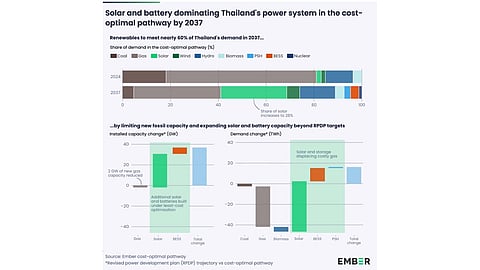

Ember recommends that Thailand add 32 GW more solar and 6 GW/15 GWh storage by 2037, in addition to the RPDP target
Expanded solar and storage could meet rising data center and EV demand while cutting fossil reliance
Following its pathway raises fixed costs to $168 billion, says Ember, but saves $16 billion in fuel costs
Thailand aims to add 64 GW of new renewable energy capacity, including 36 GW of solar and 10.5 GW of battery storage, by 2037 under its revised draft Revised Power Development Plan (RPDP). In a new report, Ember suggests adding 32 GW of solar and 6 GW/15 GWh of battery storage to this goal will enable the country to reliably meet additional data center and electric vehicle (EV) charging demand, resulting in huge cost savings.
By the target year, data centers in Thailand are expected to consume 10 TWh more electricity, while EV charging is projected to add 3.3 GW to peak demand, exceeding the current government projections.
Installing 89% more solar power and 60% more storage by 2037 than official plans could meet this growing demand. Additional solar and storage will also reduce the need for extra fossil-fuel plants, improve energy security, and attract new investments, claims the global energy think tank in its new report titled Thailand’s cost-optimal pathway to a sustainable economy.
The increase will expand Thailand’s solar capacity to 68 GW and battery storage capacity to 16 GW in the electricity mix. Solar can then account for as much as 28% of 102 TWh in its generation mix by 2037, up from 2% or 5.5 TWh in 2025, estimates the report.
The Southeast Asian nation can transition away from fossil fuels by limiting net additions of gas capacity to just 2 GW during 2035-36, while enabling the expansion of around 50 GW of renewables and 14 GW of energy storage by 2037. It recommends phasing out up to 8 GW of fossil-fuel capacity in the country, instead of suggesting a no-new-gas scenario, which it believes could risk stranded assets at gas terminals.
Thailand’s current target is to achieve carbon neutrality by 2050 by phasing out coal power plants and increasing the renewable energy share to 68% by 2040 and 74% by 2050. RPDP also factors in 6 GW of new gas additions by 2037.
The benefits of following Ember’s cost-optimal pathway will come at a cost, though, as the report writers estimate total fixed expenditure from 2024 to 2037 to be higher, at $168 billion, up from the $153 billion projected under RPDP.
Nevertheless, following its pathway and reducing new gas-fired capacity can help Thailand save close to $16 billion over the same period in avoided fossil-fuel use, claims Ember. It would translate into $1.8 billion in total cost savings for the country, including $0.8 billion in variable operation and maintenance (O&M) costs. More solar and storage in the electricity mix will also protect the country from global gas market volatility.
“The energy transition of Thailand towards home-grown renewables could lower energy costs, cut emissions, and strengthen energy security by mitigating dependence on fossil fuel imports,” said Ember’s Energy Analyst—Asia, Lam Pham.
Analysts see the pathway as achievable, provided solar and battery storage are prioritized with the right policy changes. The country should plan to enhance power system flexibility and provide incentives for residential PV-battery systems. Reduced grid extension investment incurred by these systems would compensate for the financial support, it explains.
Decentralizing power supply through small-scale solar and storage distributed systems will enable Thailand to reduce its reliance on imported gas while providing flexibility to balance supply and demand.
Fossil fuels should be redefined as peaking and backup resources rather than central pillars of the generation mix, suggest the writers.
The complete Ember report on Thailand is available for free download on its website.
